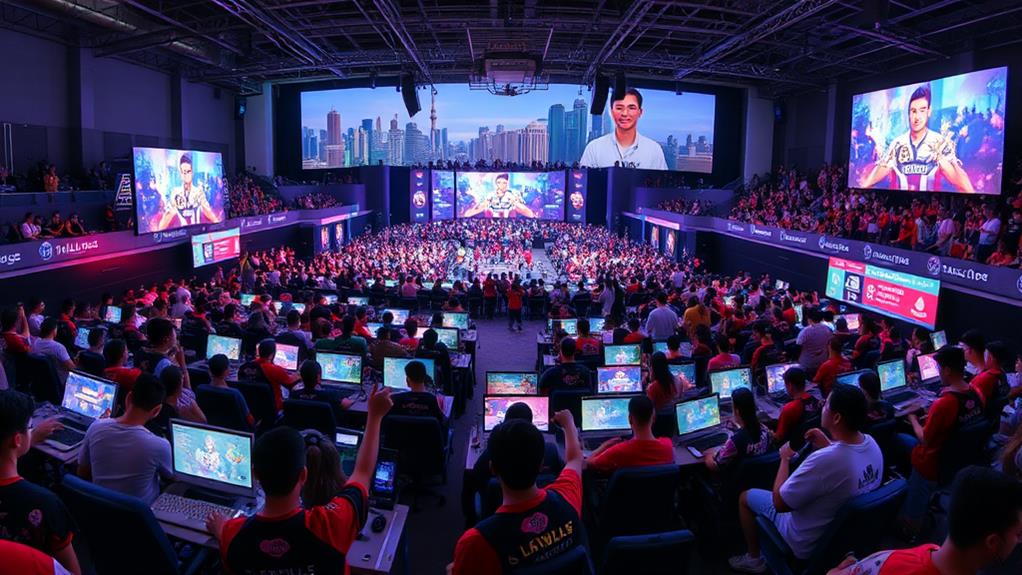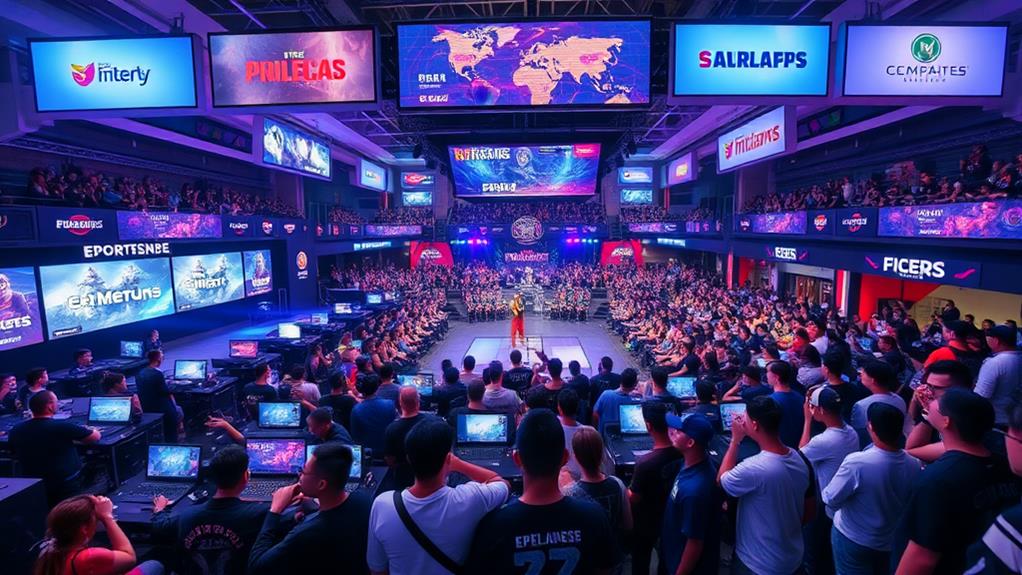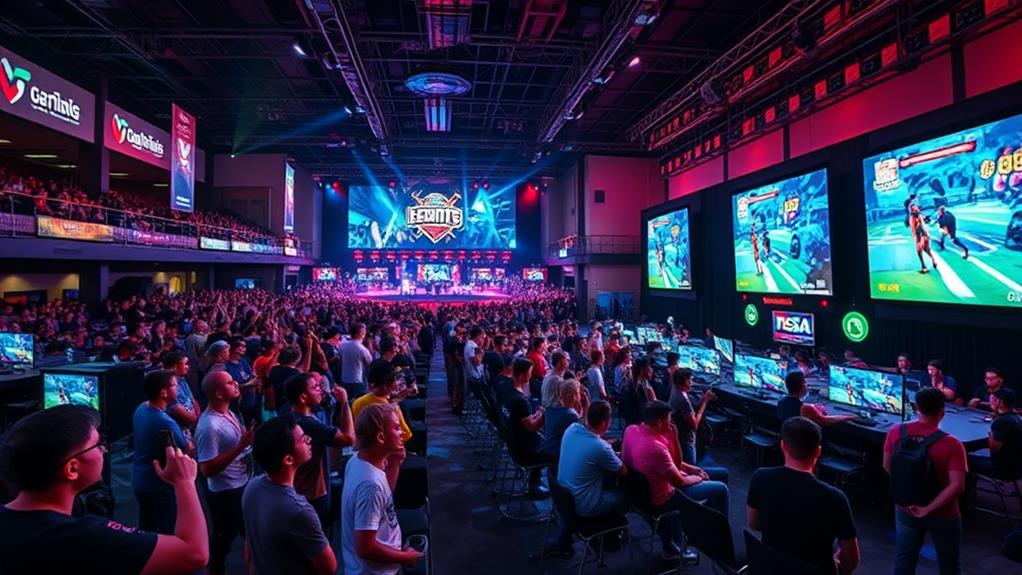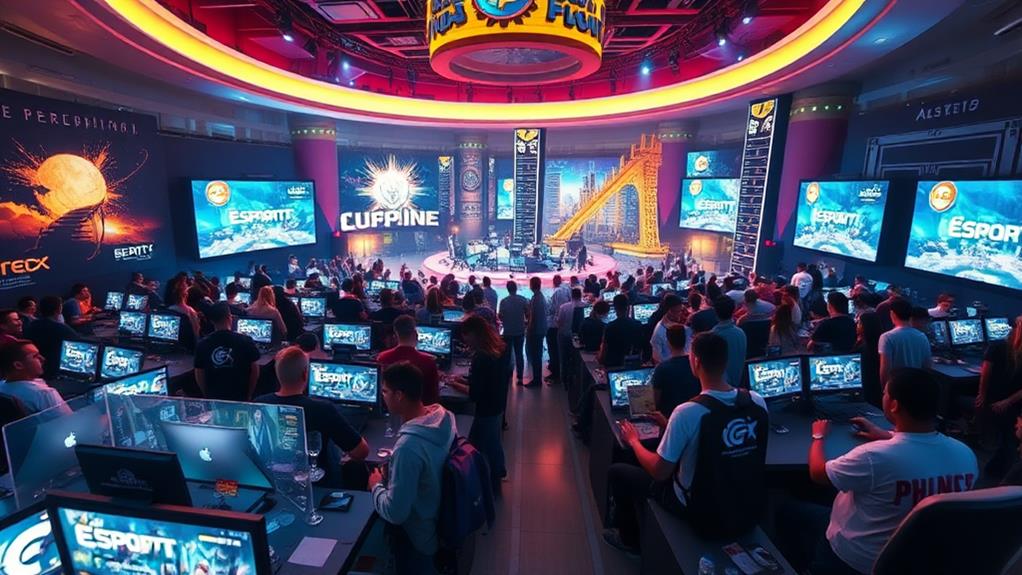The esports industry in the Philippines is a promising investment opportunity. It is expected to generate $25.1 million in revenue by 2024, with a robust growth rate of 7.02% projected until 2029.
This growth is driven by a strong user base, which is expected to reach 11.1 million by 2029, indicating increasing participation, especially among young gamers.
Esports betting is a significant contributor to this growth, set to contribute $17 million in 2024.
Despite these opportunities, challenges persist, such as inadequate infrastructure and public misconceptions about the industry.
However, prominent teams and initiatives like AcadArena are driving the local scene forward, providing a platform for young gamers to develop their skills and compete.
Understanding the dynamics of the Philippine esports industry can provide valuable insights into its potential for growth and investment.
Market Overview

The Esports market in the Philippines is poised for significant growth, with projected revenue reaching US$25.1 million by 2024 and a robust annual growth rate (CAGR) of 7.02% from 2024 to 2029. A key driver of this growth is Esports betting, which is expected to generate US$17.0 million in revenue in 2024.
The user base is expanding rapidly, with a projected 11.1 million users by 2029, representing a user penetration rate of 7.5% in 2024. The average revenue per user (ARPU) stands at US$2.82, indicating a promising potential for monetization strategies.
The rise of mobile gaming has made gaming more accessible to a broader audience, contributing to the surge in the Esports sector.
Increased investments in local Esports tournaments and infrastructure are also playing a crucial role in shaping this landscape. These factors position the Philippines as an emerging powerhouse in the Esports market, inviting further exploration and engagement from gamers and investors alike.
Global Market Comparison
The global esports market is a diverse and competitive landscape, with the United States leading with a projected revenue of US$1,070.0 million in 2024. China is the largest market, while Germany also plays a significant role, highlighting the competitive nature of this sector.
In contrast, the Philippines has a large potential for growth in its esports market, projected to reach US$25.1 million by 2024 with a CAGR of 7.02% until 2029. This growth is largely driven by the increasing number of mobile gamers, who are becoming crucial to the ecosystem.
The esports betting segment in the Philippines is particularly noteworthy, expected to generate US$17.0 million in revenue by 2024, underscoring the market's potential.
As international companies continue to invest and host esports events in the region, the Philippines is poised for tremendous growth in rising sports and esports, setting the stage for a vibrant future in this competitive landscape.
Key Players and Dynamics

Key Players Drive Esports Growth
Prominent teams like ONIC Philippines, FaZe, and TSM are driving significant sponsorships and investments in the Philippine esports scene. The Philippine Esports Organization (PeSO), established in 2011, has been instrumental in promoting local esports growth and recognition nationally and internationally.
Evolving Esports Ecosystem
The Philippines' large and young population is eager to engage in competitive video gaming, rapidly evolving the esports ecosystem.
AcadArena's $3.5 million funding reflects a commitment to enhancing local infrastructures and opportunities for aspiring players, vital for sustaining growth and broadening the talent pool.
Lucrative Revenue Streams
Esports betting revenue is projected to reach $17.0 million by 2024, indicating a lucrative segment within the industry.
Major events like the M3 World Championship, which garnered a peak viewership of 3.1 million, showcase the increasing engagement and investment potential in this thriving sector.
Investment Opportunities
The Philippine esports market is poised for significant growth, presenting investment opportunities worth US$25.1 million in revenue by 2024. This growth is fueled by a compound annual growth rate (CAGR) of 7.02% through 2029.
Esports betting is the largest market segment, expected to reach US$17.0 million in 2024. This rapid expansion makes it an attractive area for both local and foreign investors.
For example, AcadArena's grassroots esports initiatives provide unique investment opportunities in amateur leagues and player development, fostering a new generation of talent.
The Philippines has a large and growing gaming population, with 43 million active gamers and an anticipated user base growth to 11.1 million by 2029. Companies targeting this demographic will find lucrative prospects.
The Philippine government's recognition of esports as a professional sport since 2017 further enhances the sector's attractiveness by opening doors for increased investment and sponsorship.
Growth Potential

The Philippine esports market holds significant growth potential, driven by increasing user engagement and diverse revenue streams. By 2024, the market is projected to reach US$25.1 million in revenue, with a 7.02% compound annual growth rate (CAGR) from 2024 to 2029.
The user base is expected to expand, reaching 11.1 million active gamers by 2029, primarily consisting of a young demographic eager for esports content.
Esports betting is the largest market segment, projected to generate US$17.0 million in 2024, presenting a lucrative investment opportunity.
Mobile gaming is on the rise, forecasted to reach $1.5 billion by 2025, solidifying the Philippines' position in the Southeast Asian gaming landscape.
Additionally, increased sponsorship and advertising revenues are driven by a growing number of local and international esports tournaments, further highlighting the expanding business opportunities within the esports ecosystem.
What are the potential investment opportunities in the rapidly growing e-sports industry in the Philippines?
The esports industry growth in philippines presents a multitude of potential investment opportunities. With the increasing popularity of competitive gaming in the country, there is a high demand for infrastructure development, sponsorships, and talent management. Investing in esports teams, event organization, or gaming facilities can yield substantial returns in this rapidly expanding market.
Challenges and Barriers
Infrastructure Limitations
The Philippine esports industry lacks essential infrastructure, hindering its growth.
Advanced training academies and improved sports venues are essential to nurture local talent and host competitive events. Without these facilities, the industry struggles to develop and attract top players.
Public Misconceptions
Public understanding of esports remains limited, often overshadowed by negative perceptions about gaming.
Educational initiatives are necessary to elevate awareness and change these perceptions, ensuring the industry's continued growth.
Regulatory Issues
Inconsistent government support creates uncertainty, deterring potential investors.
Clear regulations and government backing are crucial to attract investors, essential for the industry's growth.
Talent Gap and Competition
The talent gap in esports is a significant challenge.
Skilled professionals in game development and management roles are scarce, while participation in esports surges.
Local esports organizations also face fierce competition for sponsorship and advertising revenues, struggling to secure funding against established global brands.
Overcoming Barriers
Addressing these challenges is vital for the sustainable growth of esports in the Philippines.
By overcoming these barriers, the industry can unlock its full potential.
Future Trends

The Philippine esports market is projected to grow at a CAGR of 7.02%, reaching a volume of US$35.3 million by 2029. This growth is largely fueled by the anticipated rise of mobile gaming, with the number of mobile gamers expected to hit 37 million by 2027.
Private investments are driving the growth of local esports initiatives. For instance, AcadArena's grassroots development funding and Manny Pacquiao's Team Pacquiao GG demonstrate a growing recognition of the business potential within the gaming industry.
The establishment of competitive amateur leagues will bolster the esports ecosystem. These leagues will attract local and international investors, and collaborations with educational institutions to develop esports programs will enhance skill development and talent identification.
Advanced technology will elevate the competitive landscape and draw more spectators to esports events. As the industry matures, this integration will play a crucial role in shaping the future of esports in the Philippines.
The Philippines is poised to become a promising hub for esports. The dynamic interplay of investment, growth, and community engagement positions the country for significant development in the industry.
Questions and Answers
How Big Is Esports in the Philippines?
Esports in the Philippines is a rapidly growing industry. This growth is driven by the country's active gaming community and the popularity of local tournaments, which encourage youth participation. For example, the Philippine Pro Gaming League (PPGL) has become a premier esports competition, attracting thousands of participants and spectators.
Mobile gaming is the dominant force in the Philippines' esports scene. This is due to the widespread use of mobile devices and the accessibility of mobile games. As a result, streaming platforms like Facebook Gaming and YouTube Live have become essential for esports athletes to gain exposure and interact with their fans.
The Philippines is increasingly involved in international esports competitions, which has led to a rise in sponsorship opportunities. Brands like Globe Telecom and Smart Communications have invested heavily in esports, providing financial support to teams and players.
This influx of funding has enabled esports athletes to pursue gaming as a full-time career, with some players earning up to ₱1 million (approximately $20,000 USD) per month.
What Is the Growth Rate of the Esports Industry?
The esports industry is growing rapidly, with a projected compound annual growth rate (CAGR) of 7.02% from 2024 to 2029. This growth is driven by the increasing popularity of mobile gaming and online streaming platforms, which are expanding the esports audience demographics.
For instance, the number of esports viewers is expected to reach 646 million by 2023, up from 454 million in 2020.
The growth of esports is also fueled by increasing tournament prize pools and the development of esports education programs. Tournament prize pools have been rising steadily, with The International 2021 Dota 2 tournament boasting a record-breaking prize pool of over $40 million.
As a result, sponsorship opportunities are expanding, and grassroots gaming initiatives are contributing to the growth of the industry. For example, the NBA 2K League, a joint venture between the NBA and Take-Two Interactive, has partnered with major brands such as Coca-Cola and AT&T.
How Much Money Is Invested in Esports?
The esports industry has attracted significant investments across various revenue sources.
Sponsorship deals and tournament funding have been a major draw for investors. For instance, brands like Coca-Cola and Mercedes-Benz have invested heavily in esports sponsorships. Additionally, gaming companies like Riot Games and Blizzard Entertainment have invested millions in tournament funding.
Revenue from merchandise sales, fan engagement, and streaming platforms also contributes to the financial growth of the industry.
Merchandise sales, such as team jerseys and gaming accessories, have become a lucrative revenue stream. Moreover, fan engagement through social media and live events has opened up new revenue opportunities. Streaming platforms like Twitch and YouTube Live have also generated substantial revenue through subscription fees and ad revenue.
The industry's financial prospects are expected to continue growing, with projected investments reaching new heights.
According to market projections, the esports industry is expected to reach $1.5 billion in revenue by 2025, up from $950 million in 2020. This growth is driven by increasing investor interest, rising viewership, and expanding revenue streams.
How Much Do Esports Players Make in the Philippines?
In the Philippines, professional gamers can earn a significant income.
Player salaries vary widely depending on skill level and market demand. Top players can earn between $1,000 to $10,000 monthly from sponsorship deals and tournament winnings. For example, a skilled player who wins several tournaments can earn up to $10,000 in a month, while a less skilled player may only earn $1,000.
Streaming revenue adds an extra layer of income. Many professional gamers in the Philippines also stream their gameplay online, earning money from subscriptions and donations. This can add hundreds or even thousands of dollars to their monthly income.
Team contracts can provide a stable income. Professional gamers can also earn a salary from their teams. Elite players can earn up to $5,000 monthly from their team contracts, while less experienced players may start at around $500 per month.
As the esports industry continues to grow, career longevity appears promising, and average earnings are projected to rise substantially. This means that professional gamers in the Philippines can expect to earn a higher income in the future.